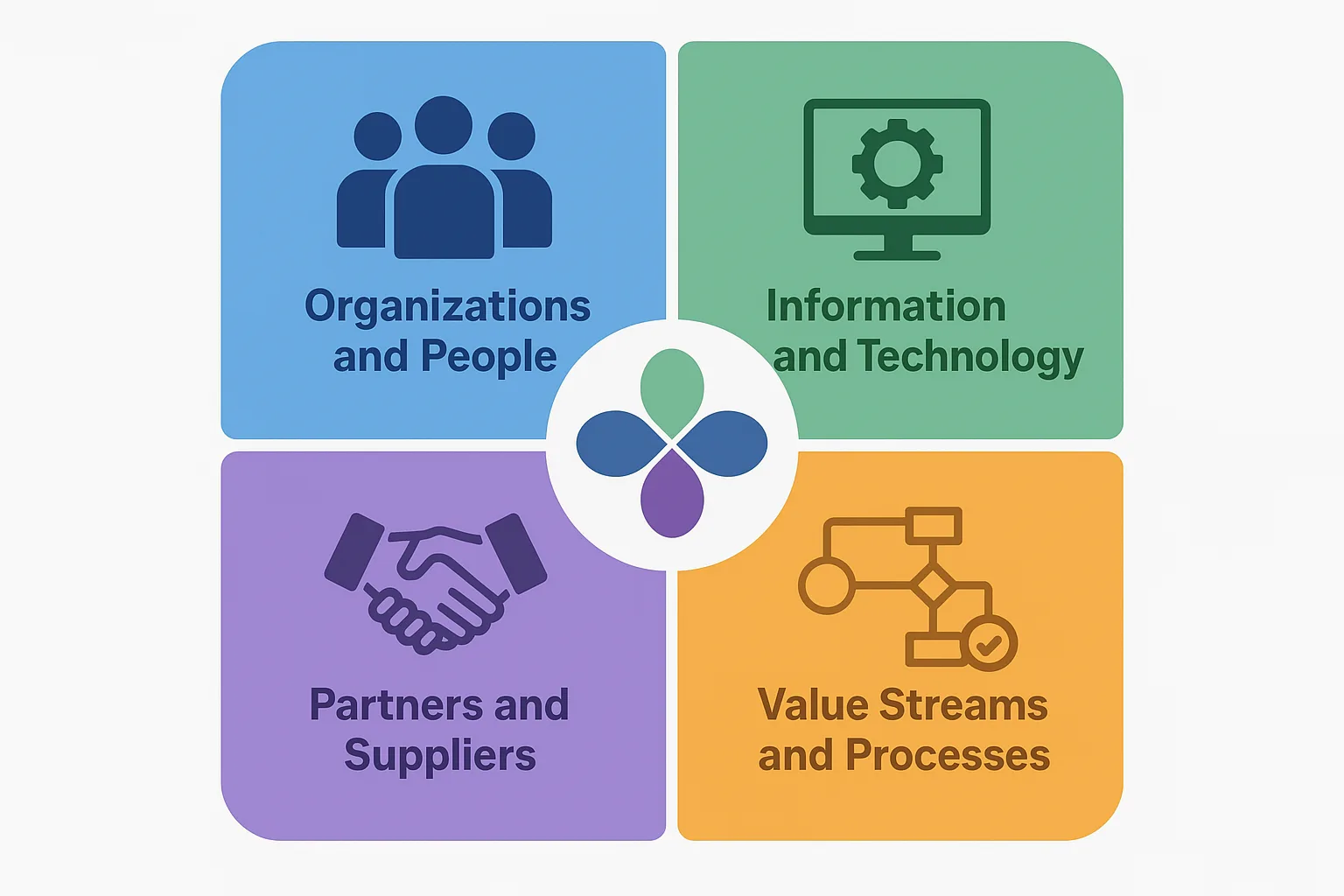The Information Technology Infrastructure Library (ITIL) has long served as the global standard for IT service management (ITSM). With the release of ITIL V4, the framework modernized its approach to suit today’s fast-paced digital landscape. At its core, ITIL V4 introduces the Four Dimensions of Service Management—a holistic model that ensures service quality, agility, and value creation.
These four dimensions work collectively to support a balanced and effective service management system, helping organisations maintain consistent service delivery and alignment with business goals.
1. Organizations and People
This dimension focuses on the human element of service management. It encompasses the company culture, communication methods, roles, responsibilities, and overall capability of the workforce.
Key Considerations:
- Organizational structure and leadership
- Culture and behavior of staff
- Competencies and skills of individuals
- Capacity and staffing levels
For services to be successful, there must be a clearly defined and well-communicated organizational structure. Teams must be empowered, trained, and equipped to adapt to change, innovate, and continuously improve service delivery.
2. Information and Technology
This dimension covers the technological tools and data required to deliver and manage services. It includes the architecture, applications, databases, cloud services, and the information used across the service lifecycle.
Key Considerations:
- Technology supporting service delivery (e.g., ITSM platforms, monitoring tools)
- Integration and compatibility of systems
- Information security and compliance
- Data availability, integrity, and accuracy
Organizations must choose the right technology stack that not only meets current demands but is also scalable for future needs. Equally important is the quality of information that supports decision-making and daily operations.
3. Partners and Suppliers
No organization operates in isolation. This dimension involves the external entities that support or enable the organization’s service capabilities. This includes vendors, outsourced service providers, and strategic alliances.
Key Considerations:
- Relationship management with third parties
- Shared responsibilities and service agreements (e.g., SLAs)
- Risk management in external partnerships
- Geopolitical and regulatory compliance
Understanding the supplier ecosystem and managing dependencies is crucial. ITIL V4 encourages organizations to build trust-based, transparent relationships with partners to mitigate risks and enhance service delivery.
4. Value Streams and Processes
This dimension focuses on how value is created and delivered through structured workflows and process management. It looks at the steps, activities, and resource flows that convert inputs into desired outcomes.
Key Considerations:
- Definition and optimization of value streams
- Alignment of processes with customer value
- Process ownership and governance
- Elimination of waste and bottlenecks
By mapping and optimizing value streams, organizations can streamline operations, reduce costs, and enhance customer satisfaction. ITIL V4 promotes a service value system (SVS) that integrates processes and practices with continual improvement.
Why the Four Dimensions Matter
The four dimensions are interconnected and should be addressed equally to ensure a balanced approach to service management. Overemphasizing one while neglecting others can result in service inefficiencies, poor user experiences, or strategic misalignment.
For instance, deploying the latest technology without the right people, training, or partnerships may lead to underutilized investments. Similarly, well-defined processes won’t succeed if there’s poor data quality or supplier mismanagement.
The ITIL V4 framework encourages organizations to assess and improve all four dimensions continuously, ensuring that IT services remain relevant, resilient, and value-driven.
Final Thoughts
The ITIL V4 Four Dimensions of Service Management provide a solid foundation for building a modern, adaptive, and customer-focused IT service environment. By carefully balancing the human, technological, organizational, and procedural aspects of service management, businesses can better align IT services with strategic goals while responding to change with agility and confidence.
Understanding and implementing these four dimensions is not just a best practice—it’s a critical step towards delivering high-quality, sustainable IT services in the digital age.


